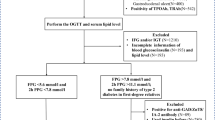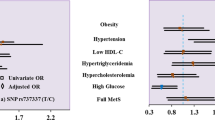Abstract
Background:
Adipocyte fatty acid-binding protein (AFABP) was recently introduced as a novel adipokine playing an important role in glucose homeostasis. In this study, we investigated the relationship between serum AFABP levels and metabolic, as well as cardiovascular parameters, in the self-contained population of Sorbs. Furthermore, we conducted a genome-wide association study on serum AFABP concentrations in the Sorbs and we separately analyzed the effects of two common variants in the FABP4 gene on AFABP serum concentration.
Methods:
Serum AFABP concentrations were quantified by enzyme-linked immunosorbent assay and correlated with metabolic and cardiovascular parameters, as well as inflammatory markers and renal function, in 868 well-characterized non-diabetic Sorbs from Germany.
Results:
Median AFABP serum concentrations were 1.5-fold higher in female subjects (23.03 μg l−1) as compared to male subjects (15.86 μg l−1). Waist-to-height ratio and glomerular filtration rate were independently associated with AFABP concentrations in multiple regression analysis in both female and male subjects. The genome-wide scan for association of single-nucleotide polymorphisms with serum AFABP levels in the Sorbs revealed 39 loci reaching P-values <10−4. Two single-nucleotide polymorphisms, rs16909187 and rs10808846, representing common genetic variation in FABP4 did not show any effect on serum AFABP concentrations in our study cohort.
Conclusion:
AFABP serum concentrations are determined by parameters of fat distribution, renal function and gender.
This is a preview of subscription content, access via your institution
Access options
Subscribe to this journal
Receive 12 print issues and online access
$259.00 per year
only $21.58 per issue
Buy this article
- Purchase on Springer Link
- Instant access to full article PDF
Prices may be subject to local taxes which are calculated during checkout


Similar content being viewed by others
References
Fasshauer M, Paschke R . Regulation of adipocytokines and insulin resistance. Diabetologia 2003; 12: 1594–1603.
Trujillo ME, Scherer PE . Adipose tissue-derived factors: impact on health and disease. Endocr Rev 2006; 7: 762–778.
Xu A, Wang Y, Xu JY, Stejskal D, Tam S, Zhang J et al. Adipocyte fatty acid-binding protein is a plasma biomarker closely associated with obesity and metabolic syndrome. Clin Chem 2006; 3: 405–413.
Xu A, Tso AW, Cheung BM, Wang Y, Wat NM, Fong CH et al. Circulating adipocyte-fatty acid binding protein levels predict the development of the metabolic syndrome: a 5-year prospective study. Circulation 2007; 12: 1537–1543.
Tso AW, Xu A, Sham PC, Wat NM, Wang Y, Fong CH et al. Serum adipocyte fatty acid binding protein as a new biomarker predicting the development of type 2 diabetes: a 10-year prospective study in a Chinese cohort. Diabetes Care 2007; 10: 2667–2672.
Yeung DC, Xu A, Cheung CW, Wat NM, Yau MH, Fong CH et al. Serum adipocyte fatty acid-binding protein levels were independently associated with carotid atherosclerosis. Arterioscler Thromb Vasc Biol 2007; 8: 1796–1802.
Hotamisligil GS, Johnson RS, Distel RJ, Ellis R, Papaioannou VE, Spiegelman BM . Uncoupling of obesity from insulin resistance through a targeted mutation in aP2, the adipocyte fatty acid binding protein. Science 1996; 5291: 1377–1379.
Uysal KT, Scheja L, Wiesbrock SM, Bonner-Weir S, Hotamisligil GS . Improved glucose and lipid metabolism in genetically obese mice lacking aP2. Endocrinology 2000; 9: 3388–3396.
Boord JB, Maeda K, Makowski L, Babaev VR, Fazio S, Linton MF et al. Adipocyte fatty acid-binding protein, aP2, alters late atherosclerotic lesion formation in severe hypercholesterolemia. Arterioscler Thromb Vasc Biol 2002; 10: 1686–1691.
Makowski L, Boord JB, Maeda K, Babaev VR, Uysal KT, Morgan MA et al. Lack of macrophage fatty-acid-binding protein aP2 protects mice deficient in apolipoprotein E against atherosclerosis. Nat Med 2001; 6: 699–705.
Furuhashi M, Tuncman G, Gorgun CZ, Makowski L, Atsumi G, Vaillancourt E et al. Treatment of diabetes and atherosclerosis by inhibiting fatty-acid-binding protein aP2. Nature 2007; 7147: 959–965.
Tuncman G, Erbay E, Hom X, De V I, Campos H, Rimm EB et al. A genetic variant at the fatty acid-binding protein aP2 locus reduces the risk for hypertriglyceridemia, type 2 diabetes, and cardiovascular disease. Proc Natl Acad Sci USA 2006; 18: 6970–6975.
Tonjes A, Koriath M, Schleinitz D, Dietrich K, Bottcher Y, Rayner NW et al. Genetic variation in GPR133 is associated with height: genome wide association study in the self-contained population of Sorbs. Hum Mol Genet 2009; 23: 4662–4668.
Tonjes A, Zeggini E, Kovacs P, Bottcher Y, Schleinitz D, Dietrich K et al. Association of FTO variants with BMI and fat mass in the self-contained population of Sorbs in Germany. Eur J Hum Genet 2010; 1: 104–110.
American Diabetes Association. Diagnosis and classification of diabetes mellitus. Diabetes Care 2010; 33 (suppl 1): S43–S48.
Matthews DR, Hosker JP, Rudenski AS, Naylor BA, Treacher DF, Turner RC . Homeostasis model assessment: insulin resistance and beta-cell function from fasting plasma glucose and insulin concentrations in man. Diabetologia 1985; 7: 412–419.
Stumvoll M, Van Haeften T, Fritsche A, Gerich J . Oral glucose tolerance test indexes for insulin sensitivity and secretion based on various availabilities of sampling times. Diabetes Care 2001; 4: 796–797.
Chu JW, Abbasi F, Beatty GW, Khalili M, Koch J, Rosen A et al. Methods for quantifying insulin resistance in human immunodeficiency virus-positive patients. Metabolism 2003; 7: 858–861.
Levey AS, Stevens LA, Schmid CH, Zhang YL, Castro III AF, Feldman HI et al. A new equation to estimate glomerular filtration rate. Ann Intern Med 2009; 9: 604–612.
Purcell S, Neale B, Todd-Brown K, Thomas L, Ferreira MA, Bender D et al. PLINK: a tool set for whole-genome association and population-based linkage analyses. Am J Hum Genet 2007; 3: 559–575.
Barrett JC, Fry B, Maller J, Daly MJ . Haploview: analysis and visualization of LD and haplotype maps. Bioinformatics 2005; 2: 263–265.
Heid IM, Henneman P, Hicks A, Coassin S, Winkler T, Aulchenko YS et al. Clear detection of ADIPOQ locus as the major gene for plasma adiponectin: results of genome-wide association analyses including 4659 European individuals. Atherosclerosis 2010; 2: 412–420.
Stejskal D, Karpisek M . Adipocyte fatty acid binding protein in a Caucasian population: a new marker of metabolic syndrome? Eur J Clin Invest 2006; 9: 621–625.
Haider DG, Schindler K, Bohdjalian A, Prager G, Luger A, Wolzt M et al. Plasma adipocyte and epidermal fatty acid binding protein is reduced after weight loss in obesity. Diabetes Obes Metab 2007; 5: 761–763.
Merabet E, Dagogo-Jack S, Coyne DW, Klein S, Santiago JV, Hmiel SP et al. Increased plasma leptin concentration in end-stage renal disease. J Clin Endocrinol Metab 1997; 3: 847–850.
Zoccali C, Mallamaci F, Tripepi G, Benedetto FA, Cutrupi S, Parlongo S et al. Adiponectin, metabolic risk factors, and cardiovascular events among patients with end-stage renal disease. J Am Soc Nephrol 2002; 1: 134–141.
Sommer G, Ziegelmeier M, Bachmann A, Kralisch S, Lossner U, Kratzsch J et al. Serum levels of adipocyte fatty acid binding protein are increased in chronic haemodialysis. Clin Endocrinol (Oxf) 2008; 69: 901–905.
Nordfors L, Lonnqvist F, Heimburger O, Danielsson A, Schalling M, Stenvinkel P . Low leptin gene expression and hyperleptinemia in chronic renal failure. Kidney Int 1998; 4: 1267–1275.
Nishizawa H, Shimomura I, Kishida K, Maeda N, Kuriyama H, Nagaretani H et al. Androgens decrease plasma adiponectin, an insulin-sensitizing adipocyte-derived protein. Diabetes 2002; 9: 2734–2741.
Horn R, Geldszus R, Potter E, von zur MA, Brabant G . Radioimmunoassay for the detection of leptin in human serum. Exp Clin Endocrinol Diabetes 1996; 6: 454–458.
Ma Z, Gingerich RL, Santiago JV, Klein S, Smith CH, Landt M . Radioimmunoassay of leptin in human plasma. Clin Chem 1996; 6 (Part 1): 942–946.
Seeger J, Ziegelmeier M, Bachmann A, Lossner U, Kratzsch J, Bluher M et al. Serum levels of the adipokine vaspin in relation to metabolic and renal parameters. J Clin Endocrinol Metab 2008; 1: 247–251.
Kapoor D, Clarke S, Stanworth R, Channer KS, Jones TH . The effect of testosterone replacement therapy on adipocytokines and C-reactive protein in hypogonadal men with type 2 diabetes. Eur J Endocrinol 2007; 5: 595–602.
Tsou PL, Jiang YD, Chang CC, Wei JN, Sung FC, Lin CC et al. Sex-related differences between adiponectin and insulin resistance in schoolchildren. Diabetes Care 2004; 2: 308–313.
Blaudeau TE, Hunter GR, Sirikul B . Intra-abdominal adipose tissue deposition and parity. Int J Obes (Lond) 2006; 7: 1119–1124.
Richards JB, Waterworth D, O’Rahilly S, Hivert MF, Loos RJ, Perry JR et al. A genome-wide association study reveals variants in ARL15 that influence adiponectin levels. PLoS Genet 2009; 12: e1000768.
Acknowledgements
This work was financially supported by the Federal Ministry of Education and Research (BMBF), Germany, FKZ: 01EO1001 (IFB Adiposity Diseases, project K7-3 to MF), the German Research Council (KFO-152 to MB, MF and MS), the Interdisciplinary Center for Clinical Research, University of Leipzig (B25 to MF; B27 to AT, PK and MS) and the German Diabetes Association (to AT, PK, and SK). We thank Knut Krohn (Microarray Core Facility of the Interdisciplinary Centre for Clinical Research, University of Leipzig) for the genotyping/analytical support and Joachim Thiery (Institute of Laboratory Medicine, Clinical Chemistry and Molecular Diagnostics, University of Leipzig) for clinical chemistry services. We also thank Nigel W Rayner (WTCHG, University of Oxford, UK) for the bioinformatics support and Beate Enigk (Interdisciplinary Centre for Clinical Research, University of Leipzig) for excellent technical assistance in the lab.
Author information
Authors and Affiliations
Corresponding author
Ethics declarations
Competing interests
The authors declare no conflict of interest.
Rights and permissions
About this article
Cite this article
Tönjes, A., Kralisch, S., Lössner, U. et al. Metabolic and genetic predictors of circulating adipocyte fatty acid-binding protein. Int J Obes 36, 766–773 (2012). https://doi.org/10.1038/ijo.2011.162
Received:
Revised:
Accepted:
Published:
Issue Date:
DOI: https://doi.org/10.1038/ijo.2011.162
Keywords
This article is cited by
-
Calcium-dependent release of adipocyte fatty acid binding protein from human adipocytes
International Journal of Obesity (2014)
-
Adipocyte fatty acid binding protein: a novel adipokine involved in the pathogenesis of metabolic and vascular disease?
Diabetologia (2013)



